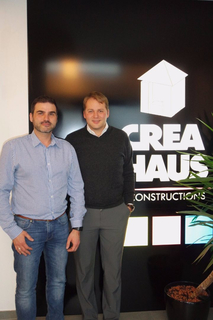
Construction The concept of sustainability to the fore
A new standard in force from 1 January.
The European Directive 2010/31, which requires that new buildings have nearly zero energy consumption between now and 31 December 2020, calls upon Member States to prepare for the implementation of nZEB targets. Luxembourg, a pioneer in this legislation, from 1 January 2017 is making the passive, sustainable house the construction standard. What are the differences between this and the low energy house? The details with Crea Haus Constructions S.A.
We already knew about the low energy consumption house. From now on, the nZEB house (Nearly Zero Energy Building) has become the construction standard, and must meet even higher levels of sustainability criteria. New developments mark this standard that is more flexible and beneficial for future house owners and builders.
More flexible criteria…
For building a house in 2016, the directional aspect was a determining factor. A maximum possible area of glazed surfaces had to be facing south, there had to be underfloor heating, a square architectural design… So many criteria that are so unfavourable for so many. “The client could not build on the land of their choice. In fact, in a large number of villages, the PAG [general development plan] in force prohibited flat roofs, and an incorrect directional aspect could prevent the implementation of a project altogether”, explains Richard Thibo from Crea Haus Constructions (which has been in Luxembourg for 26 years). The aspect, the shading, and the wind surface area: if one was unlucky, with an incorrect directional aspect, construction would not be possible. “From now on, even if the plot does not face in the right direction, building will still be possible. Landowners benefit, and this will eventually contribute to alleviating the current problem of a shortage of building land”.
So in 2017, things are going to be different. The solar gain also has less influence on the overall construction project, even though we may still prefer a south-facing aspect. “The idea is to offer the same conditions of acceptability for houses build in valley or in a town as those in the countryside. In Neudorf, for example, some plots were no longer buildable, as it was impossible to comply with the required standards”, explains Serge Faber, manager of Convex, and vice-chairman of the Fédération de conseillers et certificateurs énergétiques [Federation of energy advisers and certifiers]. Similarly, the heat pump will no longer be obligatory. “It is now possible to heat using gas, once one combines radiators with solar panels for domestic hot water, and double flow controlled mechanical ventilation.”
And beneficial for all the specialist trades involved
New houses will also be easier in the planning. From the developer’s perspective, these new standards are a good thing. “All this is helpful for us, as it had become very difficult and expensive to implement projects. It was noted that the regulations put in place in 2008 went a bit too far, and that the gains were not as significant as expected. One generally had to wait many years for a return on investment“, confirms Richard Thibo. The corrections in the new standard reflect the reality much better. And all the different branches of this sector are satisfied with it. “For architects and all the engineering specialists, it had become a real headache!” From an architectural point of view, things are also different. While the house in cube form was built in large volumes, “which did not please everyone”, the OAI [Order of Architects and Consulting Engineers] defended the imperative of greater architectural flexibility in the construction of houses. And we are now seeing the return of the pitched roof. The nZEB construction concept will enable future buyers to have more freedom of imagination, and to design the house of their dreams.
A cheaper house
Not only does this standard solve most of the problems encountered, but it enables lower construction costs. “For new projects, we have been able to drop our prices by 5 to 6% between 2016 and 2017, because the whole unit is more cohesive in terms of aspect and insulation”, explains David Pinto, director of the housing department at Crea Haus. Furthermore, the law of 23 December 2016 enacting the introduction of certification for the sustainability of housing and modifying the law of 25 February, is intended to promote the sustainability of housing in Luxembourg by establishing the “LENOZ” certificate (“Lëtzebuerger Nohaltegkeets-Zertifikat fir Wunngebaier” [Luxembourg residential building sustainability certificate]). “Because construction to the nZEB standard is a requirement from 1 January, the assistance that was previously linked to the energy performance of buildings no longer really exists”. And even though this certification remains optional, financial assistance for drawing up this sustainability certificate is however provided for. And the PRIMe House (MDDI) assistance regime for the construction of new housing is based on forty or so criteria from the LENOZ certification system. “General contractors need to design housing in accordance with sustainable development principles. This involves, for example, using recyclable materials, working with companies that have certain certifications, and also continuing education and training”. While these materials entail higher purchase prices, the ability to build in a different way and where you want to means an overall cost that is lower than it was for construction in 2016. Some encouragement for future home-owners!
